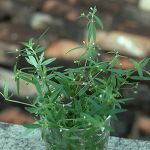| Common Name: |
Snake-Needle Grass |
| Botanical Name: |
Oldenlandia diffusa |
| Genus: |
Oldenlandia |
| Family: |
Rubiaceae |
| Native Location: |
China |
| Cultivation: |
Damp soil in partial shade. |
| Propagation: |
By seed sown in spring. |
| Harvest: |
Plants are cut in summer and dried for use in decoctions and syrups. |
| Height: |
20-30cm (8-12in) |
| Width: |
30cm (12in) |
| Hardiness: |
Z9 |
| Parts Used: |
Whole Plant (bai hua zhe she cao) |
| Properties: |
A pleasant-tasting, cooling, alterative herb that lowers fevers, reduces inflammation, relieves pain, and is diuretic as well as anti-bacterial. It acts mainly on the liver and stimulates the immune system. |
| Medicinal Uses: |
Internally for fever, coughs, asthma, jaundice, urinary tract infections, and cancers of the digestive tract. Externally for snakebite, boils, abscesses, and severe bruising. |
| Bibliography: |
Encyclopedia of Herbs by Deni Brown Copyright © 1995, 2001 Dorling Kindersley Limited Pg 294 |

